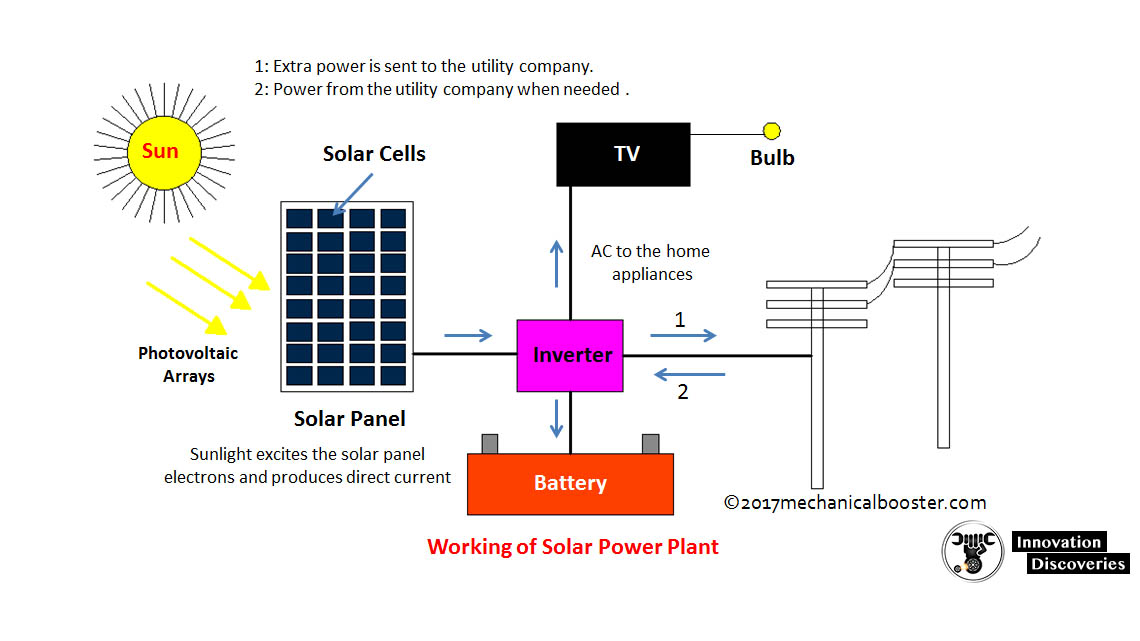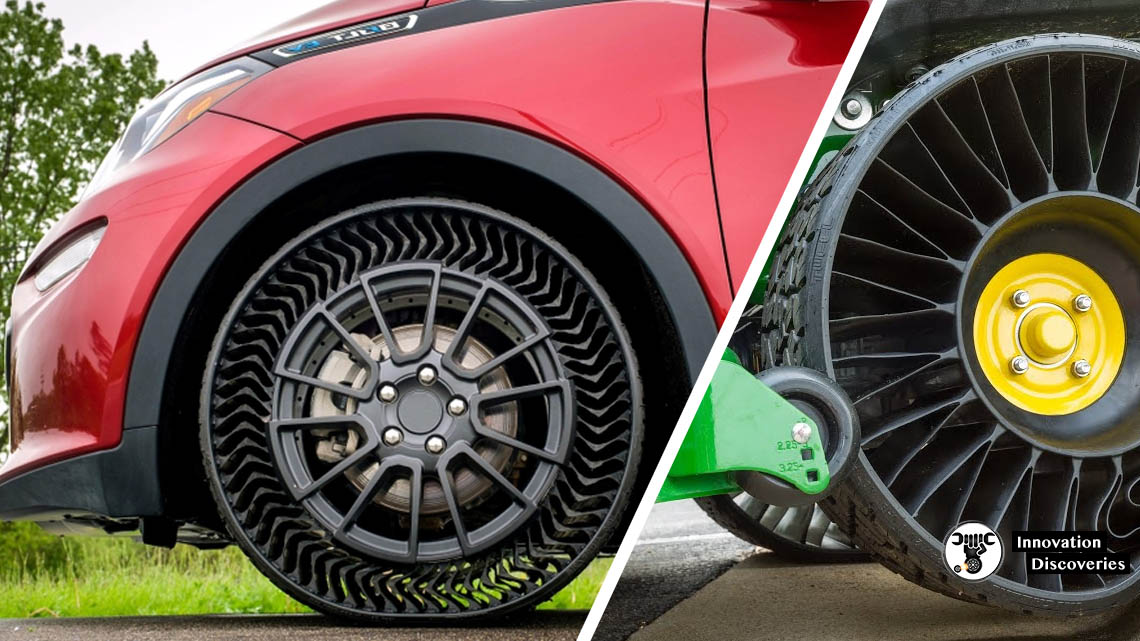
These radiations can be converted into other forms of energy such that heat and electricity by using proper equipment and setup. Solar energy can be directly converted into electricity by using photovoltaic cells or by indirect method i.e. solar power plant. The requirement of solar energy comes into play when fossil fuels have limited stock and sources which will not stay long. Solar power plants have two types both have different components, working operations and have different applications but both use solar radiation to generate electricity.
- Photovoltaic’s (PV) or Domestic Solar power plants
- Solar Thermal power plant
1. Photovoltaic’s solar power plant
This power plant has photovoltaic cells, as the name suggests for power generation. The main drawback of its initial cost because PV cells are made up silicon as we know silica/sand is available in abundant on earth but the extraction process is very costly, which increases the cost of PV cells.
Component:
A domestic solar power plant has various components that are arranged in proper sequence for generation and consumption of electricity. The following are the major components of a solar power plant.

Solar Panel:
A solar panel is made up of solar cells or small photovoltaic cells or we can say that the combinations of PV cells are known as a solar panel. This is the main component in the solar power plant. Generally, a solar power plant consists of 30-35 solar cells. We use a combination of PV cells because a single PV cell is not capable to produce high power.
Solar cells are made up of semiconductor material i.e. which is neither metal nor non-metal. Silicon is the best semiconductor used in the solar cell having properties of both metals and non-metals. Solar cells are made up of p-type and n-type silicon semiconductor. Silicon is doped by pentavalent impurity to convert it into a p-type semiconductor which has an excess number of holes or positive charge, this p-type semiconductor joint with n-type i.e. negative charged semiconductor.
The output of electricity is transferred through the transmission line at the desired location.
Inverter:
The solar panel generated D.C. power but most of the time we require AC power because most of the electric works better on AC supply so to convert DC into AC we need some equipment. So, inverter comes into the play which converts DC power supply from the solar panel into the alternating current supply.
Power Storage Device:
Sun is not available at 24 hours it is the major drawback of solar power generation. So, the major requirement of power at night as compared today that’s why the power storage system or device is required. Most of the time Lithium-ion batteries are used for power storage. The potential energy of stored water at a higher altitude will run the turbine and generates electricity.
Power Backup:
Sometimes we can’t deal with power interruption but solar power is not a continuous power generation system. In case of some emergency, we require a power backup such as electric generators, etc. In rainy seasons and winter sun is not available all the time so power backup is also a part of the solar power plant.
Controls and connectors:
These are coming into some accessories for the proper function of the system. To regulate the power we require some controls, array, circuit breaker panels, AC panels, and wires.
Working:
The sun rays come from the sun in the form of small- small energy packets known as Quanta’s or photons. This power comes out into the form of direct current to convert it into AC inverter comes into play which converts the DC into AC after that power generated by solar cell transferred to supply. The supply can be utilized directly or may be stored for later use by using Li-ion batteries. The working of solar plants continuously done until the sunlight available after that alternative source or emergency systems comes into play like generators or power stored systems.
This is the working of solar power plants having photovoltaic’s cells. The solar thermal power plant is another type of solar power plant.
2.Solar Thermal Power Plant
Solar thermal power plant is the second kind of power generation system by the solar radiations and without any use of PV cells. This kind of power plant requires a very large area for operation. The sun radiations used as fuel in the power plant. Solar energy is converted into heat or thermal energy which further use as mechanical energy to operate the turbine and generators. These cycles are based upon the solar radiation and type of collectors used for collecting solar radiation. In low-temperature cycles, the temperature is limited to about 100oc, in medium temperature range varies from 150oc to 300oc whereas in high-temperature cycles temperature may go above 300oc.
For different temperature cycles, different thermodynamic cycles are used in the power plant. Generally, for low and medium temperature ranges, the Rankine cycle is preferred whereas for high-temperature range Brayton cycle is used. The cycle operation and different components of the solar thermal power plant are given as follow

- Solar pond
- Solar energy collectors
- Working fluid
- Evaporator Boiler
- Turbine and Generator
- Condenser and Cooling tower
Solar pond: The solar energy coming from the sun firstly absorbed by the solar pond. After that solar energy increases the internal energy and raises the temperature of the solar pond. The fluid from the solar pond goes into the cyclic process.
Solar energy collectors: Solar energy collectors are the device used for collecting solar radiation and focus the solar radiation at a particular location to transfer the heat energy into the solar ponds or fluid. Collectors make solar energy more useful. Simple flat plate collectors are very simple, the collecting area is equal to absorbing area whereas focusing type collector has several arrangements of mirrors and lenses for the proper concentration of sunlight due to this by using focus type collectors we can capture 100 times solar radiation as compared to flat plate collector keeping the area same. By using a focusing type collector we can directly generate medium pressure steam.
Working Fluid:
It is the fluid used in the cyclic operation. We use some other fluid as a working fluid because sometimes solar energy is not capable to evaporate the water. We use working fluid which gains energy from the solar pond and evaporates easily or having evaporation temperature less as compare to water. Generally, brine or some organic fluids are used as the working fluid. After evaporation working fluid goes through cyclic operations in the turbine and then through a condenser, it goes again into the evaporator boiler.
Evaporator Boiler:
In this device, working fluid is kept and gains latent heat of vaporization from the sun radiations or by solar pond. Working fluid is circulating throughout the cycle by evaporating the boiler.
Turbine and Generator:
The turbine and generators are an essential part of the power generation system. The working fluid goes through the cyclic operation runs the turbine which is connected to the generator. The generator generates electricity which is transferred to the required location.
Condenser and cooling tower: After the turbine working fluid goes into the condenser, condenser and cooling tower condense the working fluid and send it back to the evaporator boiler with the help of a pump.
Working:
With the help of the construction part, we can easily predict the cycle of operation and working. Working fluid gains latent heat of vaporization from the direct solar radiations or by means of solar ponds in the evaporator boiling and converts it into vapor form. After that, it runs the turbine which is connected to the generator. This whole cycle repeated continuously until the sun remains in the sky and radiation falls on the earth’s surface.
This power plant has many drawbacks because the sun is not available all the time and power generation can’t be done continuously.
The solar power generation system has the following advantages and disadvantages.
Advantages:
- Solar power plants work on solar energy which is available in abundant on the earth’s surface at most of the places.
- Solar energy is available at free of cost.
- Solar power plants produce negligible pollution as compared to thermal power plants.
- Solar power is available at free of cost after some initial cost.
- The energy produced is renewable energy with negligible cost.
- Quantity of water use in solar power plants is very less as compared to other power plants. So, we can say that solar power plants save lots of water.
Disadvantages:
- The major drawback is the availability of the sun. Sun radiation of the desired intensity is not available the whole day.
- Solar energy is a time-dependent source of energy. We can’t rely on solar energy completely.
- If we talk about our country the sun is not available at all the location with the same intensity of radiation. The intensity of solar radiation varies according to the location. While sun rays coming to sun different factors are dominant.
- The intensity of sun radiation varies according to weather i.e. in rainy season solar energy is not available because of clouds.
- Sun light falls on earth surface in variable and inconsistent manner.
- For collecting the sun radiations at useful rate large area is required.
- Initial setup cost of PV cells is quite high.
This is all about solar power plant. If you have any query regarding this article, ask by commenting. If you like this article, don’t forget to share it on social networks. Subscribe our website for more informative articles. Thanks for reading it.






sure brother 🙂